
Parental Involvement and Family Motivational Climate as Perceived by Children: A Cross-cultural Study
[La implicaci├│n parental y el clima de motivaci├│n en la familia tal y como lo perciben los ni├▒os: estudio transcultural]
Mirtha del Prado-Morales1, Cecilia Simón-Rueda2, Aldo Aguirre-Camacho3, and Jesús Alonso-Tapia2
1Universidad Isabel I de Castilla, Burgos, Spain; 2Universidad Aut├│noma de Madrid, Spain; 3Universidad Europea de Madrid, Spain
https://doi.org/10.5093/psed2020a8
Received 10 October 2019, Accepted 20 March 2020
Abstract
The culture of a country may influence parental involvement in a student’s learning, making it more or less adequate. To test this possibility, this study analyzes the cross-cultural validity of the learning-oriented Family Motivational Climate model (FMC) as an index of parental involvement in students’ academic job and the FMC questionnaire (FMC-Q), as a way of operationalizing it. A total of 583 Spanish and 448 Cuban students filled in the FMC-Q and the questionnaire of perceived motivational changes resulting from parental practices. Confirmatory, cross-validation, and multi-group factor analyses revealed that the model showed a good fit to the data, both in the Spanish and in the Cuban samples. Besides, FMC predicted the 74% of the variance of students’ motivational change. However, the results also revealed differences between the two samples in the FMC model set up, as Spanish and Cuban students did not put down the same significance to several indicators of the model. These facts imply the need to take cultural differences into account when designing interventions aimed at changing parental involvement practices.
Resumen
La cultura de un país puede influir en la participación de los padres en el aprendizaje de los estudiantes, consiguiendo que sea más o menos adecuada. Para poner a prueba esta posibilidad, este estudio analiza la validez transcultural del modelo de clima motivacional familiar (FMC), orientado al aprendizaje como índice de participación de los padres en el trabajo académico de los estudiantes, y del cuestionario FMC (FMC-Q), como modo de operacionalizarlo. Un total de 583 estudiantes españoles y 448 cubanos cumplimentaron el FMC-Q y el cuestionario de cambios motivacionales percibidos atribuidos a las prácticas de los padres. Los análisis factoriales confirmatorios de validación cruzada y multigrupo revelaron que el modelo mostró un buen ajuste en los datos, tanto en las muestras españolas como en las cubanas. Además, el FMC predijo el 74% de la variación en el cambio motivacional de los estudiantes. Sin embargo, los resultados también mostraron diferencias en la configuración del modelo FMC en las dos muestras, ya que los estudiantes españoles y cubanos no atribuyeron la misma importancia a varios indicadores del modelo. Estos hechos implican que hay que tener en cuenta las diferencias culturales al diseñar intervenciones dirigidas a cambiar las prácticas de participación de los padres.
Palabras clave
Participaci├│n de los padres, Clima motivacional familiar, Motivaci├│n para aprender, Expectativas de ├®xito, Satisfacci├│n de los estudiantesKeywords
Parental involvement, Family motivational climate, Learning motivation, Success expectancies, ChildrenŌĆÖs satisfactionCite this article as: Prado-Morales, M. D., Simón-Rueda, C., Aguirre-Camacho, A., & Alonso-Tapia, J. (2020). Parental Involvement and Family Motivational Climate as Perceived by Children: A Cross-cultural Study. Psicolog├Ła Educativa, 26(2), 121 - 128. https://doi.org/10.5093/psed2020a8
mirtha.delprado@ui1.es Correspondence: mirtha.delprado@ui1.es (M. del Prado-Morales).Several authors have shown that parental involvement – its degree and quality – has a deep influence on learning motivation and achievement (Boonk et al., 2018; Cheung et al., 2016; Jeynes, 2017; Madjar et al., 2016; Wilder, 2014). However, the meta-synthesis of parental involvement in academic achievement carried out by Wilder (2014) and Boonk et al.’s (2018) review of the relationship between parental involvement indicators and academic achievement have also shown that the positive effects of parental involvement depend on the specific characteristics of it, as relationships were not always found positive. Therefore, it is necessary to clarify the construct and to develop a measure that operationalize it in order to make the specific characteristics referred to in intervention studies clear. A first factor that may explain the lack of convergent results in interventions on parental involvement may be the type of assessment instrument used to measure it. Different meta-analyses synthesized by Wilder (2014) have analyzed the effect of parental involvement on children’s achievement. In the studies revised, different assessment instruments were used that allow gathering information from the point of view of teachers (Calderon, 2000), adolescents (Anderson-Butcher et al., 2013; Finley & Schwartz, 2004) or a combined sample of parents, teachers, students, and high rank educational civil servants (Fisher, 2016). However, these instruments are too general, that is, the content of each one does not include all the parents’ or caregivers’ behavior patterns that can affect students’ motivation and achievement: parent-child communication, home supervision, tutoring learning activities at home, enforcement of rules regarding school and leisure activities, and school contact and participation. Therefore, the type of instrument used, due to its underlying model, may be one of the factors underlying the fact that not always the relationships found were positive, as it happens with “parental control” (Cheung et al., 2016). A second factor that may be responsible for the lack of convergence of intervention results is culture. Different cultures emphasize different values (Plaut & Markus, 2005). Cross-cultural studies have found both similarities and differences in parental practices related to academic performance. For instance, studies conducted with Chinese, Latin-American, and African-American samples have shown that students are more motivated to learn when they understand their parents’ messages about the value of education as a means to achieving higher social status and appreciate their parents’ efforts (Buriel, 2009; Ceballo et al., 2014; Suizzo et al., 2016). However, other studies focused on socialization practices among Spanish and Anglo-Saxon families and studies carried out with Chinese students have shown that the type of socialization practices that promote academic performance differs across these cultures (Castro et al., 2015; Chen, 2015; Fuentes et al., 2015). In order to achieve an adequate operationalization of parental involvement, Alonso-Tapia et al. (2013) developed the Family Motivational Climate questionnaire, that includes all the behavior patterns above mentioned organized in a model of parental involvement. As will be shown later, it has very good psychometric characteristics. However, given the fact that differences in culture may be responsible for differences in its structure, it was decided to test its cross-cultural validity. Theoretical Background Alonso-Tapia et al. (2013), based on Pomerantz et al. (2005), pointed out that there is consensus among many authors in that the three most important factors influencing parental practices related to children’s learning process are: a) the emotional relationship between parents and children, b) the expectations of parents regarding their children’s academic performance; and, c) the value attributed to learning (Cheung & Pomerantz, 2012; Pomerantz et al, 2005). It has been proposed that these three factors have a positive impact on the level of parental involvement in the learning process (Sin-Sze & Pomerantz, 2015) because they lead to the satisfaction of four basic needs in children: competence, autonomy, relatedness, and purposefulness. The quality of the “emotional relationship” between parents and children may materialize in the ties that are constructed, dialogues that are propitiated, messages that are communicated, tone of voice, active listening when confronted with difficulties, and feedback and emotional support received. That is, a close emotional relationship helps children feel recognized, competent, stimulated, and autonomous, which fosters learning and achievement motivation (Jeynes, 2007). Also, “academic expectations” of parents constitute one of the factors that are most influential on their children’s achievement motivation, in accordance with a meta-analysis by Jeynes (2007). In fact, children’s perceptions of their own level of competence are influenced by their parents’ perceptions; these are conveyed through parental practices in the form of expectations, beliefs, and parents’ attributions regarding their children performance and results within their academic context (Rivera & Milicic, 2006). Further, “the value that parents attribute to the learning process of children” is also a factor influencing parental practices (Cheung & Pomerantz, 2012; Pomerantz et al, 2005). If parents ascribe an intrinsic value to learning and the resulting opportunities leading to optimal development, it is likely that many of their actions will be directed at creating good learning environments for their children. This may materialize in the messages they transmit, in the creation of good study environments, in norms set at home, in the relationship with school and teachers, in the cultivation of their children’s autonomy, and in the level of control they exert over their children’s leisure time. However, the value parents ascribe to learning may also be reflected on their daily routines. This can set a positive example to their children by showing, for instance, sensitivity towards reading, the appreciation for culture, and the search of opportunities for informal learning and acquisition of general knowledge. These three factors lead to the different “patterns of action” pointed out in the above cited studies on parental involvement. Theses patterns configure what Alonso-Tapia et al. (2013) called Family Motivational Climate (FMC), a concept inspired in a related one, “classroom motivational climate” (Ames, 1992). Here, the term “climate” is used because it is the “interaction” between patterns of action what contributes to the motivational orientation of students; “motivational” is used because such patterns can promote learning or performance-oriented goals; and “family” is used because such climate emerges from patterns of action within a family context. The parental patterns of action that configure FMC, in accordance with the model initially validated in Spain, are shown in Figure 1 The model shown in Figure 1 was developed on the base of previous studies. On one hand, research on the motivational value of different patterns of action in the school and family contexts provided important results. For example, in the school context it is better to make comments that take students’ attention towards the process to be followed, rather than comments that may foster competition with each other, as the former strengthen the orientation to the domain (Pardo-Merino & Alonso-Tapia, 1990). For the same reason, it is better to make comments that stress the importance of learning rather than the importance of obtaining high grades (Alonso-Tapia & Pardo, 2006; Ames, 1992; Hullemann et al., 2010). In a similar way, several studies on the effect of different family socialization practices have revealed the importance of structuring the schoolwork and activities of children, of insisting that homework is completed, of establishing clear norms and good communication, and that parents set good examples (Coolahan et al., 2002; Jeynes, 2007; Pomerantz et al., 2005). In addition, there is evidence that a closer collaboration of parents with schools has positive effects (Álvarez & Martínez-González, 2016; Epstein et al., 2009). Besides, some of the meta-analyses and reviews above quoted (Boonk et al., 2018; Wilder, 2014) have shown that the type of home supervision, the way of tutoring learning activities at home, the existence or not of enforcement of rules regarding school and leisure activities, and family relation with teachers and participation in school activities influence children motivation to learn. Table 1 Factors and Variables Comprised in the Family Motivational Climate Model and corresponding Example items from the Family Motivational Climate Questionnaire  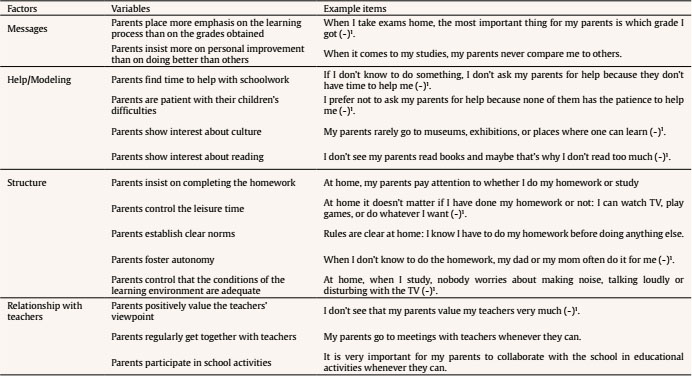 1(-) = Reverse-coded items. The model just described includes the main factors pointed out in studies of interventions of parental involvement. It was the base of the FMC model proposed and validated by Alonso-Tapia et al. (2013) in Spain. However, given the fact that differences in culture could be responsible of differences in its structure, it was decided to evaluate whether the model and the questionnaire were also valid in the Cuban cultural context. The reason for choosing this context was that the educational authorities in Cuba gave us the possibility of carrying out the study. Participants A convenience sample of 1,031 students from two public schools in Madrid, Spain (n = 583, 282 female) and Santiago de Cuba, Cuba (n = 448, 224 female) took part in the study. All students were attending secondary school at the time of participation, and their age ranged from 12 to 17 years (MSpain = 14.2, SDSpain = 1.7; MCuba = 13.5, SDCuba = 1.7). The distribution of students in terms of school-years in the Spanish sample was 1st: 118, 2nd: 98, 3rd: 109, 4th: 108, 5th: 99, and 6th: 51, whereas the distribution in the Cuban sample was: 1st: 134, 2nd: 116, 3rd: 99, 4th: 37, 5th: 44, and 6th: 18. Procedure The study was approved by the ethics committees from the Universidad Autónoma de Madrid, Spain, and the Universidad de Oriente, Cuba; also, the study protocol was approved by the school boards from the schools in Madrid and Santiago de Cuba. Informed consent was obtained from the parents of the students who took part in the study. The study was carried out outside class hours, in 50-minute sessions with groups of 30 students. The data was gathered in a way that preserved anonymity of participants. Measures Family Motivational Climate Questionnaire (FMC-Q) (Alonso-Tapia, et al., 2013). FMC-Q contains 28 items evaluating the extent to which students’ learning motivation is influenced by parental practices. The 28 items are grouped into 14 variables, each with a negative and a positive item grouped in four scales (factors). Students’ responses are provided using a 5-point Likert scale ranging from 1 (completely agree) to 5 (completely disagree). The internal consistency (Cronbach’s α) in the original study was .85. Table 1 contains an example of items comprising of each variable, as well as the variables loading each of the factors of the FMC model. Table 2 Goodness-of-fit Statistics of the Confirmatory Factor Analyses (CFA 1-5) and Path-analysis with Latent Variables (PALV)   Questionnaire of Perceived Motivational Ahanges Attributed to Parental Practices. (Alonso-Tapia et al., 2013). This questionnaire, developed in the same study as the FMC model, assesses changes that children attribute to parental practices. The internal consistency of the six scales comprised in this questionnaire obtained in the original study was: resilience (RS) (α = .57), perceived ability (PAB) (α = .80), learning effort (EFF) (α = .76), interest (INT) (α = .80), success expectancies (SE) (α = .79), and satisfaction (SAT) (α = .64). Data Analysis Factor analysis. The Spanish and Cuban samples were randomly divided into two subsamples to carry out some of the factor analyses. Overall, five confirmatory factor analyses (CFA) were performed to determine whether the data obtained with the FMC-Q showed a good fit to the FMC theoretical model. Two analyses were initially carried out to replicate the original analyses within the Spanish sample (Alonso-Tapia et al., 2013). The first analysis (CFA1) was carried out with the data from the first subsample of Spanish students. Then, a multigroup analysis (CFA2) was performed using the two sub-samples of Spanish students to determine the crossed-validity of FMC-Q. The same analyses (CFA3 and CFA4) were conducted with the Cuban sample to examine whether the model showed a good fit within the Cuban context. Last, a multi-group analysis by country was carried out in order to verify if there were differences between the Spanish and Cuban students. These analyses were performed using the statistical software AMOS-22 and the method of maximum verisimilitude. The model fit was assessed using absolute fit indices (χ2, χ2/df, GFI, SRMR), relative fit indices (IFI), and non-centrality fit indices (i.e., CFI, RMSEA), as well as the criteria of acceptance/rejection proposed by Hair et al. (2010) (i.e., χ2/df < 5, GFI, IFI, and CFI > .90, RMSEA < .08). Finally, the Z statistic proposed by Clogg et al. (1995) was used to analyze the slope differences between the samples from Spain and Cuba. Reliability. McDonald’s (1999) ω coefficient was used to calculate the internal consistency of each scale. Path analysis with latent variables. As a first step to determine FMC-Q predictive validity, a path analysis with latent variables was carried out combining the Spanish and Cuban samples. Here, FMC-Q was used as the latent predictive variable and the changes in resilience, perceived ability, effort, interest, success expectancies, and satisfaction were used as outcome variables. Factor Analyses of Data from Spanish Students Confirmatory factor analysis (CFA-1). Table 2 shows the fit indices of the proposed model (CFA-1) and Figure 2 shows the standardized parameters corresponding to the confirmatory model in the Spanish sample. All estimated weights (λ) were significant (p < .001). Even though the χ2 statistic may have reached significance due to the large size of the sample (Hair et al., 2010), the quotient χ2/df = 2.29 < 5, as well as indices GFI = .92 >.90 and RMSEA = .07 < .08 were clearly located within the confidence limits, which resulted in acceptance of the model. Other two indexes, IFI = .89 and CFI = .88 were just below the limit of standard significance levels (> 90), and for this reason the analysis of crossed validation (CFA-2) was performed. Figure 2 Family Motivational Climate Questionnaire. Confirmatory Factor Analysis with Spanish Students (CFA-1).  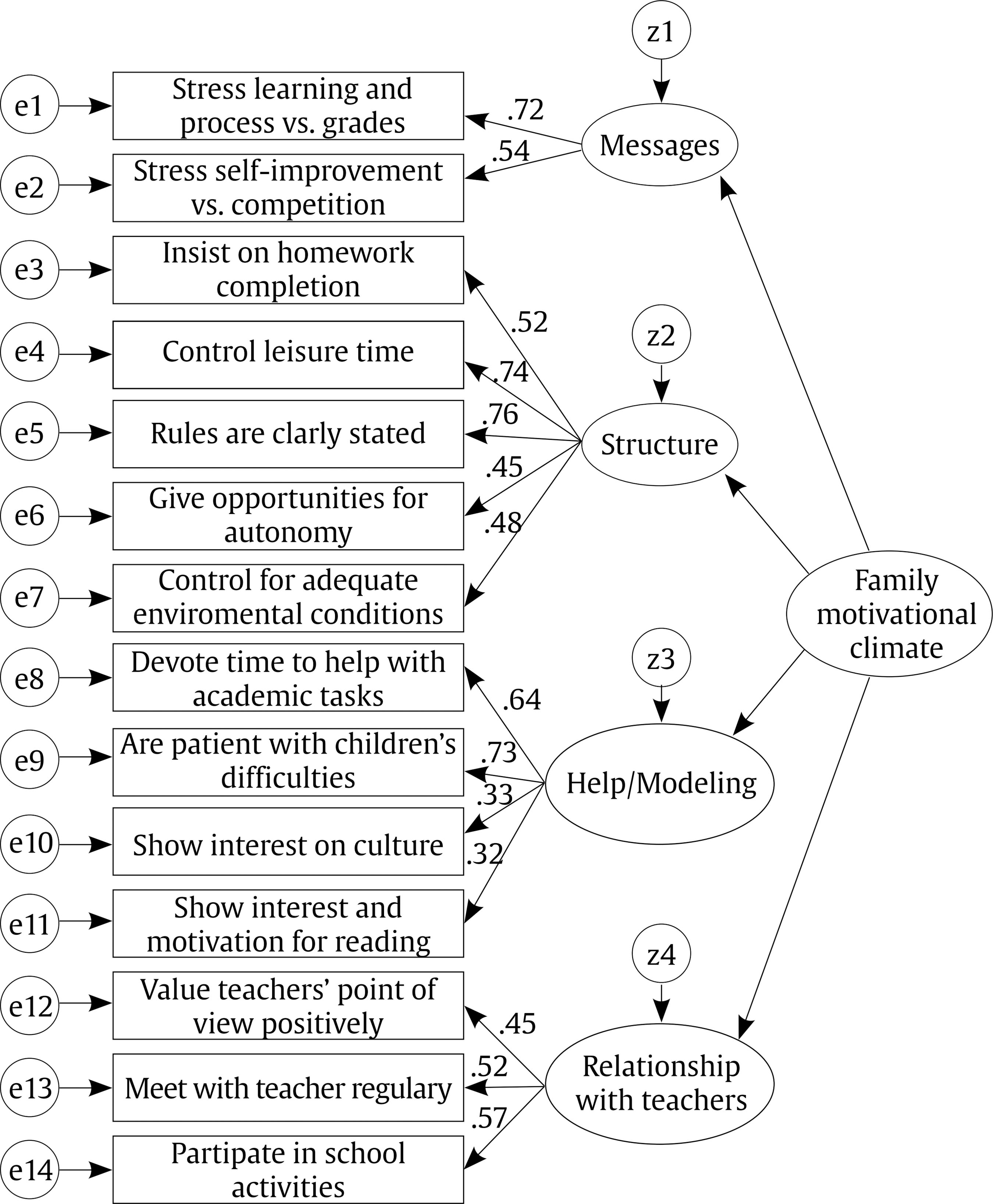 Crossed validation: Multi-group analysis with the Spanish subsamples (CFA-2). Fit indices fell within the confidence limits (Table 2, CFA-2), and the model parameters shown in Table 3 revealed that model fit did not decrease significantly even if restrictions were imposed in measurement weights, structural weights, structural covariances, structural residuals, and measurement residuals. Table 3 CFA-2: Cross-validation of the Model through a Multi-group Analysis with the Subsamples of Spanish Students. Differences in χ2 in the Comparison of Models with Equality Constraints vs. the Model without Equality Constraints of Parameters   Factor Analyses of Data from Cuban Students Confirmatory factor analysis (CFA-3). Figure 3 shows the standardized coefficients of the confirmatory model in the Cuban subsample. As in the Spanish subsample, the estimated coefficients were significant. The results of this analysis are shown in Table 2 (CFA-3). The absolute fit indices (χ2/df = 1.43 < 5, GFI =. 93 > .90), relative (IFI = .91 > .90), and non-centralized (CFI = . 91 > .90 and RMSEA = . 04 < .5) fell within the confidence limits commonly used to accept or reject the model. Figure 3 Family Motivational Climate Questionnaire. Confirmatory Factor Analysis with Cuban Students (CFA-3).  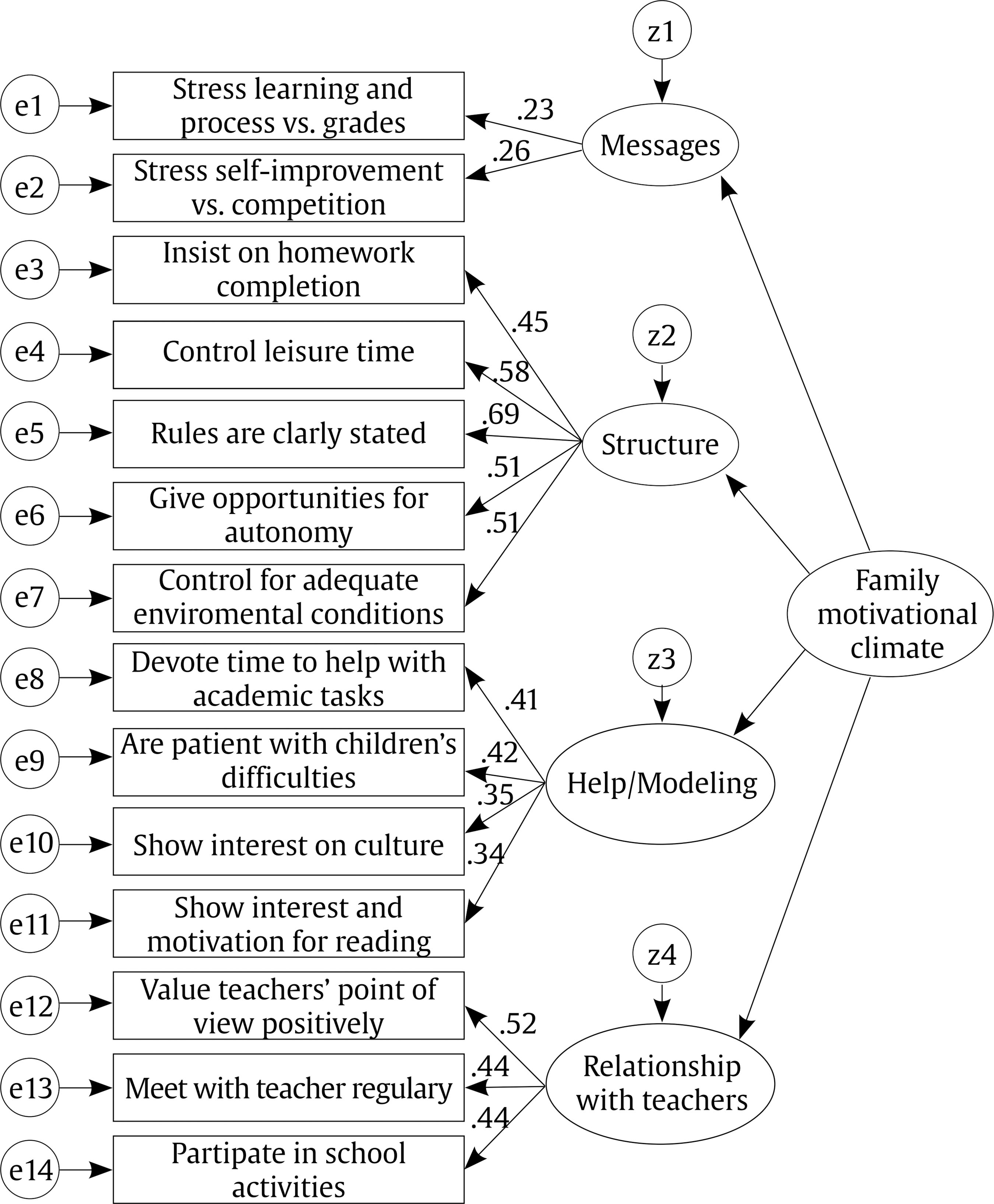 Crossed validation: multi-group analysis with Cuban subsample (CFA-4). A multigroup analysis with the two Cuban subsamples (Table 2, CFA-4) was carried out to validate the initial results. The results showed a good fit across several indicators (i.e., χ2/df, GFI, RMSEA, and SRMR), whereas in others (i.e., IFI, TLI, CFI) fit indexes fell slightly below standard levels of significance. Nonetheless, the comparison between groups showed that adjustment did not decrease even if equality constraints were imposed on the measurement weights, structural weights, the structural covariances, structural residuals, and measurement residuals (Table 4, CFA-4). Therefore, it was concluded that the model was well estimated. Table 4 CFA-4 Cross Validation (CV) of the Model through Multi-group aAnalysis with the two Samples of Cuban Students. Differences in χ2 in the Comparison of Models with Equality Constraints vs. the Model without Equality Constraints of Parameters   Multi-group Analysis of Spanish and Cuban Samples The results of the comparison between the Spanish and Cuban students, carried out using multi-group confirmatory factor analysis, is presented in Table 2 (CFA-5 MG). As can be seen, χ2/df, GFI, RMSEA and SRMR showed a good fit, although the rest of the indices (i.e., IFI, TLI, IFC) were slightly below the standard significance levels. In this case, the comparison between groups showed that the adjustment changed if equality constraints were imposed on the different parameters (Table 5, CFA-4). Therefore, the significance of the differences between parameters was evaluated using the Clogg et al.’s (1995) Z test to determine the factors in which there were significant differences between the two groups. The results of this analysis (Table 6) showed that there were significant differences between three variables: the autonomy parents give to their children in performing school activities (Z = 3.01), parents’ interest in reading (Z = 2.28), and parents’ control of the environmental conditions where children study (Z = 2.20). In all cases where significant differences were obtained, the weights were higher in the Cuban sample. Table 5 CFA-5 Cross Validation (CV) of the Model through Multi-group Analysis with the two Samples of Spanish and Cuban Students. Differences in χ2 in the Comparison of Models with Equality Constraints vs. the Model without Equality Constraints of Parameters   Table 6 Analysis of Differences in Non-tandardized Regression Weights in the Scales of the Family Motivational Climate Questionnaire between Spanish and Cuban Students  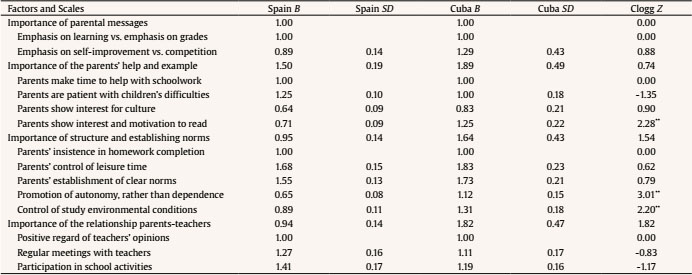 **p < .01 Reliability Analysis McDonald’s (1999) ω coefficients were calculated for all scales of the FMC-Q (Table 7). The results showed that all ω coefficients reached acceptable levels of significance in both the Spanish and Cuban samples. Path Analysis with Latent Variables The results of the path analysis with latent variables are shown in Figure 4, and the fit indices are presented in Table 2. Similarly to the previous analyzes, χ2 index was significant, and even though this may have been due to the large size of the sample, the rest of the indices fell within the confidence limits, which resulted in the acceptance of the model. It is worth noting that the FMC model predicted 73.96% of the explained variance in the students’ motivational change attributed to parental practices. Figure 4 Students’ Perceived Changes in Motivation and Satisfaction Attributed to Parental Practices. Combined Spanish and Cuban Samples  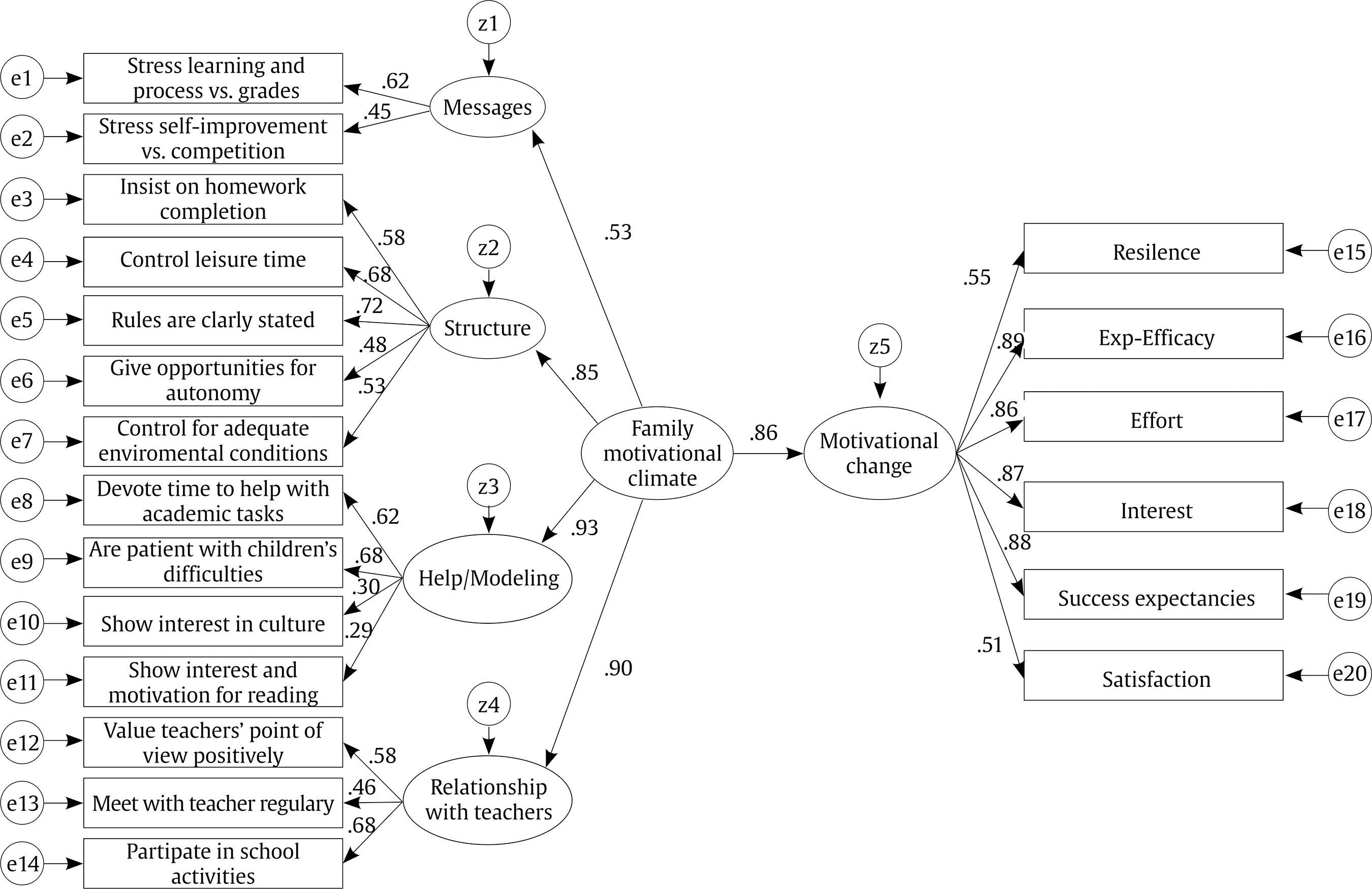 The objective of the present study was to investigate the extent to which the FMC theoretical model developed in Spain by Alonso-Tapia et al. (2013) as an index of parental involvement was valid in the Cuban context. The results showed that the cross-cultural validation within the Cuban context was successful, as data showed a good feet to the model. Nonetheless, the results also revealed cultural differences in terms of configuration of the FMC model. First, the results supported the structural validity of the theoretical model underlying the FMC-Q in both cultures. The four dimensions assessed by the FMC-Q significantly contributed to the good fit of the model. Messages conveyed by parents to their children define communication styles that promote a learning-oriented FMC, as long as these messages encourage self-improvement over competition and emphasize the learning process rather than the grades obtained. Likewise, daily family routines can contribute to the emergence of a learning-oriented FMC by: a) providing adolescents with opportunities to learn in an autonomous way during their leisure time and structure for their study at home, b) instilling in children, from the example set by parents, interest in learning new things, reading, and enjoying culture in general and, c) valuing and trusting the education that teachers and school offer to students. The importance of the parental behavioral patterns just mentioned, included in the FMC-Q, had been pointed out in different studies of parental involvement (Cheung & Pomerantz, 2012; Finley & Schwartz, 2004; Pomerantz et al., 2005, 2007). Therefore, the FMC-Q seems to be a good way of assessing all of them in an integrated way, as they do not act in an isolated way. Second, predictive validity analyses supported the expected results. CMF-Q predicted 70.50% (Spanish sample) and 88% (Cuban sample) of the variance in the scores indicating changes that students attributed to parental practices. In the same way that in the original study, both Spanish and Cuban students reported that learning-oriented parental practices had a positive impact on their interest and effort to learn, on their sense of competence, on their success expectations, and on their resilience level. In addition, learning-oriented parental practices increased the level of of children with their parents. However, no other studies, as far as we know, have analyzed the specific relations between FMC-Q factors and interest, sense of competence, success expectations, resilience, and satisfaction with parents. Nevertheless, positive relations found in this study are in line with positive relations between parental involvement and motivation found in involvement literature (Boonk et al., 2018; Cheung & Pomerantz, 2012; Finley & Schwartz, 2004; Pomerantz et al., 2005; Pomerantz et al., 2007; Wilder, 2014). Third, even though the model was equally valid in both cultures, the results revealed differences between Spanish and Cuban students in terms of the pattern of parental practices considered to increase their motivation to learn. Cuban students, to a greater extent than Spanish students, considered important that their parents encourage them to have more autonomy, ensure that study environments were appropriate to carry out school activities, and that parents set an example in terms of showing interest in reading. Differences in the expression of these factors have also been found in previous studies carried out within Asian, Latino-American, and Afro-American contexts (Buriel, 2009; Ceballo et al., 2014; Suizzo et al., 2016), which highlights the relevance of cultural context for parental practices. Fourth, some authors consider autonomy and parental control as factors whose effects on learning motivation are opposite (Cheung et al., 2016). According to this view, autonomy has a positive influence on learning motivation by increasing self-confidence and leading students to follow their own initiative, whereas parental control may be perceived as an imposition to meet parental demands, which may have a negative effect on learning motivation. However, it is worth noting that according to our results both factors promote a learning-oriented FMC in Spain and Cuba. In this study however, parental control was not operationalized as synonym of imposition, but rather as supervision of school activities and presence of family structure (see Table 1). With the provision of supervision and family structure, the students’ exercise of autonomy may have had a stronger positive impact on learning than when such characteristics are lacking. Nonetheless, autonomy and control of school activities at home were two of the factors (along with interest for reading) perceived differently by Spanish and Cuban students. Even though both factors were positively valued, the value ascribed by Cuban students was significantly higher than that ascribed by Spanish students. These findings have an important theoretical implication. They underlie the adequacy of using FMC-Q as a way of operationalising parental involvement in student academic activities, as it includes all main factors pointed out in the literature, and show that the structure identified by Alonso-Tapia et al (2013) is also valid at least for two countries with different cultures. However, as the study of Pomerantz et al. (2007) suggest, the factors assessed through the FMC do not include other conditions than can moderate their effect, as parental involvement may by better for some children than for others. Therefore, the conditions moderating the effect of FMC should be dealt with in new studies. In terms of practical implications, the FMC model can serve as a guide for implementing psychoeducational interventions aimed at increasing a learning-oriented FMC. As suggested by the results of predictive validity analyses, it is expected that students’ interest, motivation, and performance will improve to the extent that parents gain awareness of implications of acting in accordance with a learning-oriented FMC, and behave in consequence. Nonetheless, according to our results, interventions must be sensitive to cultural differences. Findings of the present study should be interpreted in light of some limitations. First, the effect of parental involvement manifest in FMC was not evaluated in relation to academic performance. Second, parents’ educational level was not assessed. It might have influenced parental involvement. Third, cross-cultural validation of FMC was carried out from the perspective of students only. Therefore, future studies should also evaluate the validity of this model from parents’ perspective and identify potential differences when compared with students’ perspective. Conflict of Interest The authors of this article declare no conflict of interest. Acknowledgments The authors thank Professors Maritza Morales Sánchez, Yolanda Mercerón, Mayra del Toro, Clara Suárez and Heidy Rodríguez Marzo, from Universidad de Oriente, Santiago de Cuba, for their collaboration in this research. Cite this article as: Del Prado-Morales, M., Simón-Rueda, C., Aguirre-Camacho, A., & Alonso-Tapia, J. (2020). Parental involvement and family motivational climate as perceived by children: A cross-cultural study. Psicología Educativa, 26(2), 121-128. https://doi.org/10.5093/psed2020a8 Funding: Financial support was received from a Grant from the Spanish Ministry of Economy Competitiveness (Ministerio de Economía y Competitividad, FPI 2014-2018. Edu2012-3782). References |
Cite this article as: Prado-Morales, M. D., Simón-Rueda, C., Aguirre-Camacho, A., & Alonso-Tapia, J. (2020). Parental Involvement and Family Motivational Climate as Perceived by Children: A Cross-cultural Study. Psicolog├Ła Educativa, 26(2), 121 - 128. https://doi.org/10.5093/psed2020a8
mirtha.delprado@ui1.es Correspondence: mirtha.delprado@ui1.es (M. del Prado-Morales).Copyright © 2025. Colegio Oficial de la Psicología de Madrid










 e-PUB
e-PUB CrossRef
CrossRef JATS
JATS








